Test
This article will talk about everything you need to know about shiplap siding.
After reading it, you will know about some of the materials that are commonly used for shiplap, and we’ll walk you through the advantages and disadvantages of each of the materials so as to make sure that you end up making the right choice in the progress.
We’ll also walk you through some of the other styles that you could alternatively be considering.
Are you ready to start talking with siding contractors about your project? Simply fill out the form below, and we’ll match you with the 4 most relevant contractors in your area. Not ready? That’s fine too! You can just scroll down below the form to continue reading the article.
What is Shiplap Siding and What Does it Look Like?
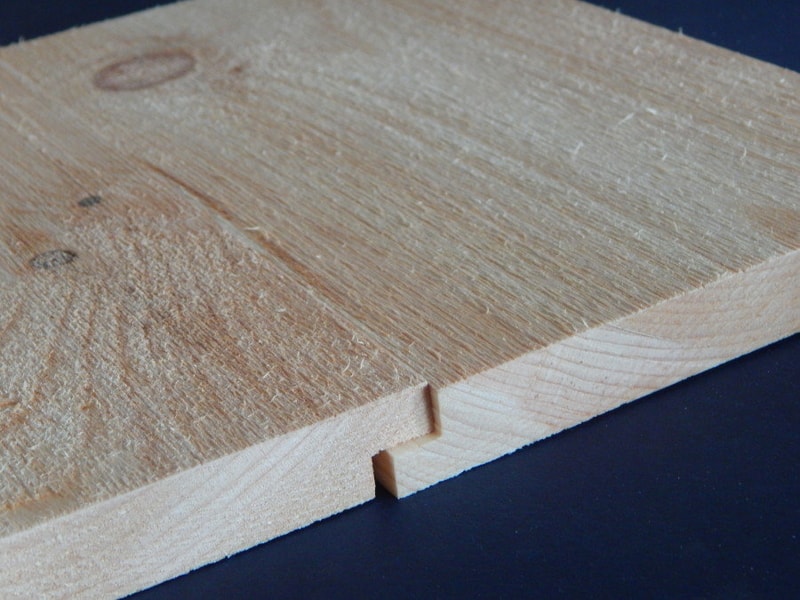
Shiplap is a type of siding that is cut in specific way so that the different boards join easily together to create a relatively tight seal between them. It is usually made out of wood but it also comes in other materials such as vinyl and fiber cement.
While it is often popular outside, it can also be installed inside houses.
It can add a rustic touch and is often used for barns, sheds and other outbuildings as well as the main house.
It is often confused with a bunch of different things, one of them simply being wood paneling, which isn’t just what it is. It can also be confused with bevel, since both of materials in fact overlap one another as to prevent water leaks, however it’s the way in which the boards are cut that makes it shiplap or not.
The photo right below is one of bevel, and as you can see those planks are milled in a more triangular shape. While they overlap, they don’t interlock. The picture above shows you a picture of what shiplap in fact and how it’s cut, and therefore what it looks like.
If you visit that claim to provide shiplap siding, you may even run into some of them claiming that’s what they do, while the interlocking mechanism they use isn’t actually shiplap.
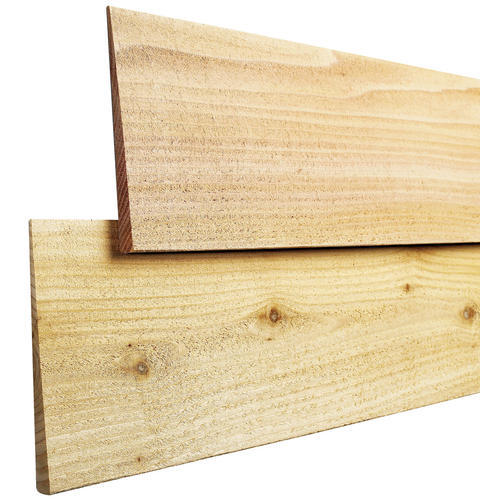
Photo credit: Menards
Because shiplap is sawed symmetrically, when you install it, the boards will connect rather tightly and it will seem like there’s barely any space between the different boards. Other types of lap siding won’t look like this.
We were once sent the image below and while we were unable to find its original source, it shows pretty clearly some of the different styles that are often confused with each other.
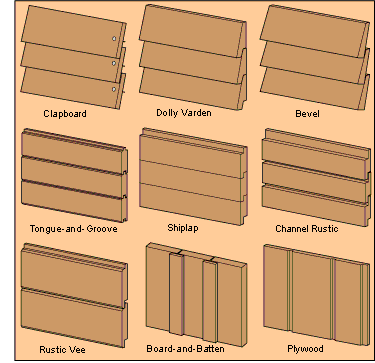
Types of Shiplap Siding – Lap vs Shiplap
The title’s a little bit misleading since there’s only one type of shiplap, while there are more types of lap siding that you should know about and they all create a look that’s a little bit different due to the way they were milled.
Shiplap, channel lap, dutch lap and nickel gap are the most popular types of lap siding.
Channel Gap
While the way of cutting channel gap looks a lot like shiplap, the final results are quite a bit different visually. This is what the boards look like before being installed.
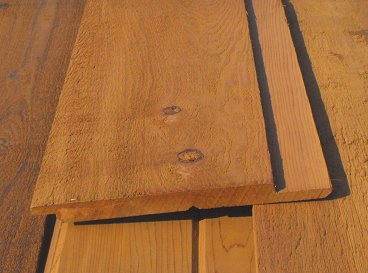
When you join the boards together, they look like the image below.
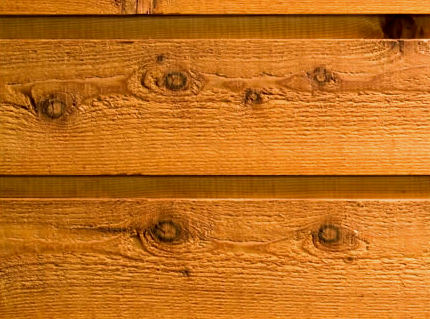
Both images were originally posted by Buffalo Lumber. In comparison, shiplap won’t have the “channel” in the middle, but rather have the boards sit a lot more tightly together.
Dutch Lap
Where the previous cuts have had straight cuts, that’s not the case with dutch lap. The way it’s sawed gives it a more unique feel that some like. While the boards interlock to some extent, they don’t connect tightly and it creates a rounded gap and shadow as a consequence. This is what dutch lap boards look like when not installed.
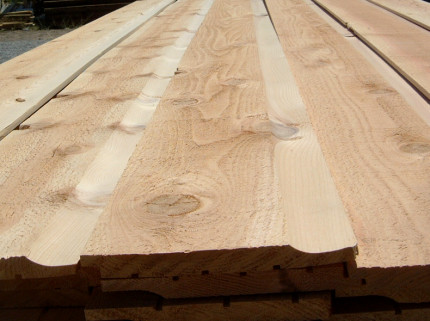
And this is what they look like once they’re stacked. As you can see, they’re basically almost against each other and as you can see it creates the rounded shadow between them where they meet.
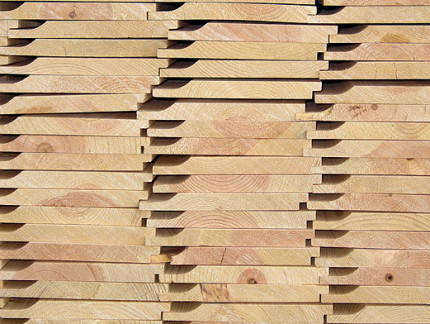
Dutch lap also comes available in vinyl which you can see below. It clearly doesn’t have the same charm that wood siding has, although often made to resemble cedar siding.
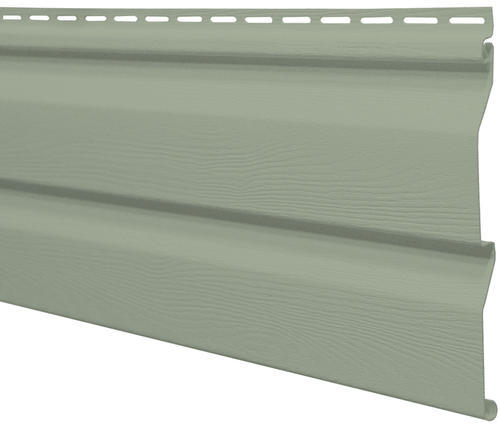
Dutch lap is also often called cove lap or German lap.
Nickel Gap
Nickel gap is a style that is cut so that it seem like a nickel could fit in between. Some of its other names include shadow line, shadow profile, shadow gap and small reveal, all of the names having in common that they seem to suggest there’s a minuscule gap between the boards. From the picture below, it’s easy to see where it gets its name from.
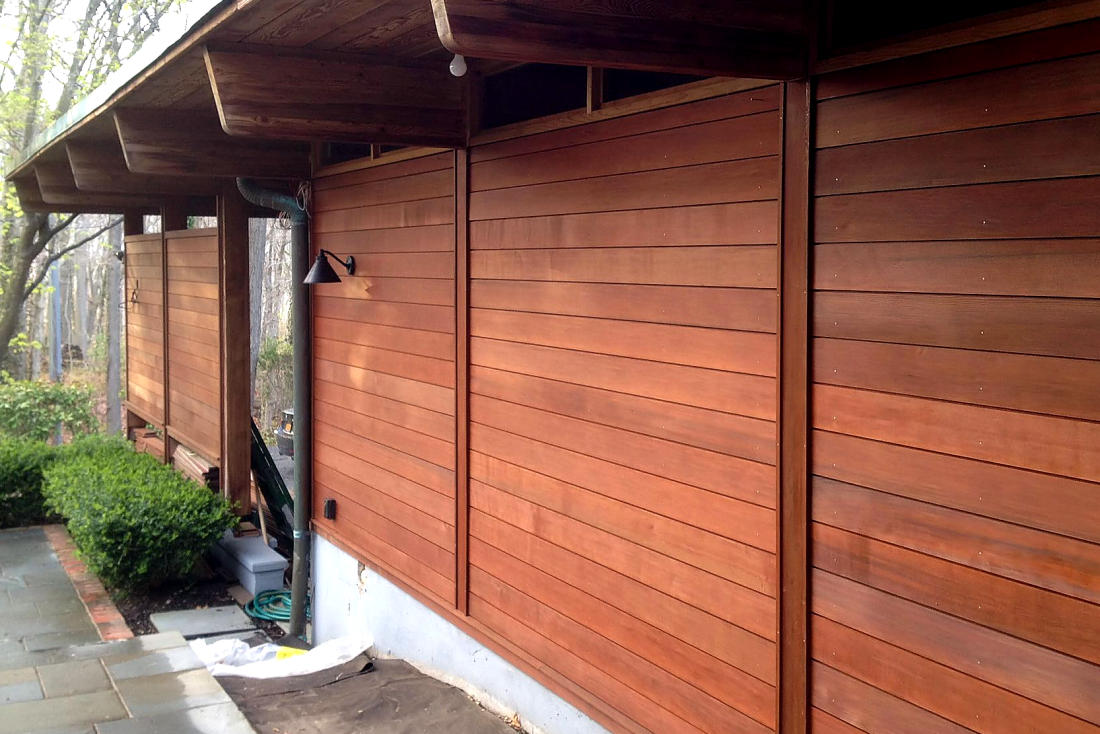
Its look is very modern, which is likely one of the reasons why it’s becoming so popular among homeowners.
Shiplap vs Tongue and Groove Siding
Where shiplap only has a single overlap, tongue and groove has two. When you compare the two, they will visually look very much the same after they have been installed, but the two overlaps in fact means that there’s more of an interlocking mechanism and the two materials will “click” together. The way it’s milled can also depend, which as with lap siding, will give different visual feels when the materials are installed.
The picture below shows two different ways that tongue and groove can be milled.

The drop siding and the carsiding are both variants of tongue and groove, where you can see that the top part will connect with the bottom mechanism.
When comparing shiplap and tongue and groove, tongue and groove comes out ahead in terms of strength and stability due to the way it interlocks. It will however also typically be more expensive to buy since it’s a more advanced way of milling the boards.
The two overlaps obviously help in terms of keeping water out better than is the case with shiplap, although if installed by a professional siding contractor, that shouldn’t be a problem with shiplap either.
Pros and Cons of Shiplap Siding
There are different pros and cons of going with shiplap siding compared to other styles and to give you a better understanding of those, we’ve prepared the sections below to help you out so as for you to make the more informed decision in the process.
While there are a lot of advantages, it’s also worth mentioning the drawbacks so that your decision is the right one.
Pros
- It’s very easy to install – compared to a lot of other siding styles, it’s incredibly easy to install. For instance, shingles and shakes will require a lot more work to have them installed, and this translates into more labor hours needed for the job, which in turn makes the cost of installation go up. The quality and protection you get from the siding material is obviously only as good as the installation, so we still do recommend that you use a pro to have it done properly.
- Horizontal and vertical installation available – it’s not all types of siding that can be installed both horizontally and vertically. The horizontal installation is still the most common option, but it doesn’t change that both options are available should you wish to pursue the vertical option instead.
- Better options when it comes to insulation – shiplap provides an easy opportunity to use felt paper as well as different types of exterior insulation which comes in handy, especially when you live in areas with extreme weather that creates certain needs for additional insulation.
- Natural and beautiful facade – it is traditionally built out of wood and nothing beats the wooden look, although several materials may try to imitate it. It just can’t be beat. It can give you that rustic appearance that you have been looking for.
- Availability in lots of different types of wood – it can be and is made from a range of different materials which means you’ll be able to find something that fits your budget and achieves the look that you want for it.
- Not too difficult to repair – repairing other types and style of siding can be costly because it takes a lot of time to fix it.
Cons
There are also certain disadvantages to going with this style that we’d like to walk you through so that your decision is informed.
- It does require maintenance to keep it looking good – it is more a disadvantage that is related to the fact that it is generally wood that is used for this type of siding more so than it’s a disadvantage related to the style specifically.
- The style may not appeal to everyone – if you want something a bit more advanced in terms of looks, there could be other styles that are more appealing to you such as the nickel gap style or something else.
- It attracts dust like nothing else – while this may not be as much of an issue outside as if it’s installed inside your home, it does need to be addressed with proper cleaning once you’re staining or painting the material at a later stage. The gaps between the different boards is an ideal place where dust can gather. The amount of gap between the boards determines how good it is at gathering dust, meaning a smaller gap will gather less dust than a bigger one will, making shiplap better than channel gap, for instance.
Maintenance Needed for Wood Siding

No matter if you’re using wood as shiplap or with another style, it’s important that you keep the siding properly maintained if you wish to have it keep its beauty and last as long as possible. Without due maintenance you will find your material deteriorating a lot faster than you’d wish. There are definitely other materials you should be going for before wood if you don’t want to engage in the act of inspecting and maintaining it actively.
While it is one of the most beautiful options you can go with, a lot of other options are significantly easier to simply install and forget – basically. I think you get the message by now, let’s jump to the actual juice.
While some types of wood are more prone to suffering from insect damage and damage from moisture, all types will benefit from being protected by either paint, stain or a sealer. Rot and decay will also happen more quickly without adequate protection and then you might also be more likely to run into carpenter bees if left unprotected too.
Expansion and contraction of the material can cause paint to chip, which is one of the reasons it will need to be repainted every 5-7 years. If you choose to seal it, you should probably be expecting to have to do it every 2-3 years. The advantage to sealing it is that it will better help bring out the rich textures of the wood which is why a lot of people prefer the look that it provides.
As a consequence of the expansion and contraction, it’s also important that you check the caulking around windows and other places. The caulking should be replaced if it starts showing signs of wear and tear, which could create holes that water enter through. The water penetrating the surface will speed up the process of the wood rotting.
Painting the house is crucial, or staining it for that matter, but if you do choose to paint it, you’ll lose some of the rich texture and it’s hard to go back to staining it after it’s been painted once already.
A stain will otherwise work by penetrating the fibers and adding a protective barrier against moisture. Unlike paint, stain doesn’t crack and chip. It doesn’t last as long either, though. Prepping the surfaces for this type of work takes less time than it does to paint it but it will need to be done more often.
If you decide to go with a clear sealer, it’s the most natural protection you can go with since you’ll be able to see what’s going on underneath and its texture but it’s also the type that needs to be redone the most frequently too.
Cleaning Your Home Frequently to Keep Dirt From Leaving Unwanted Stains
If you leave dirt sitting on the wooden siding, whether it’s shiplap or a different option, it will leave a stain over time, which is why periodic cleaning is incredibly important. What that means is that you should generally expect to have to clean the siding at least once a year with soapy water and a brush with soft bristles.
If you start seeing mildew, create a 1:4 mixture of bleach to water and be sure to use eye protection so as to not get it in your eyes. If you have plants around the house that you value dearly, it would also be a good idea to get those protected in the process. In order to make sure the bleach doesn’t stay on the house, rinse afterwards.
You can use an oxalic acid and water mixture to get rid of rust stains and be sure to read our extensive guide on removing rust too. If you’re asking yourself how wood rusts, the answer is it doesn’t. It’s the nails that may rust if they weren’t made of stainless steel or they weren’t galvanized.
Where is Shiplap Used?
While this article is mainly talking about siding, it can be installed throughout your home in various ways and has been installed in anything from kitchens to bathrooms. Next time you’re considering a kitchen remodel, figure out if shiplap deserves consideration for making your walls more interesting and unique.
Some people choose to avoid it during a bathroom remodel simply because it may be a good idea to avoid excessive use of wooden materials in places that get a lot of moisture. If you install it on the outside, you will undoubtedly need to paint or stain it to keep it protected, but if you do not wish to have the added home maintenance, you could go for more moisture-resistant materials instead.
Reverse Board and Batten vs Vertical Lap Siding
Board and batten siding is the kind where two boards are installed next to each other with a small gap between them. On the outside, the batten is installed. It can be done with a lot of different materials too depending on your personal preferences and can create a unique look unlike a lot of other styles. Here is an example of what it can look like.

Contrary, reverse board and batten is when the bigger boards are installed on the outside of the building and the batten is on the inside. If the written description didn’t suffice, you’ll here have an illustration of what it looks like.

It looks a lot like vertical lap siding when installed. Actually it looks so much like most people won’t be able to tell the difference. But we’re here to tell you that you might in fact want to choose vertical lap siding instead of reverse board and batten.
If you choose to do it with channel lap instead, you’ll still get that distinctive gap, but the installation will be significantly easier to have done (although vertical siding installation traditionally is more difficult), so if you have chosen to go vertical, you can save some money by at least not over complicating the journey it takes to get the look.
An additional advantage is that this solution will also be more water-resistant than board and batten. As you can see from the illustration, there are significantly more nails required to put the whole thing together, and a lot more seams. The seams between the boards is always where the challenges start emerging. Fewer seams, fewer problems.
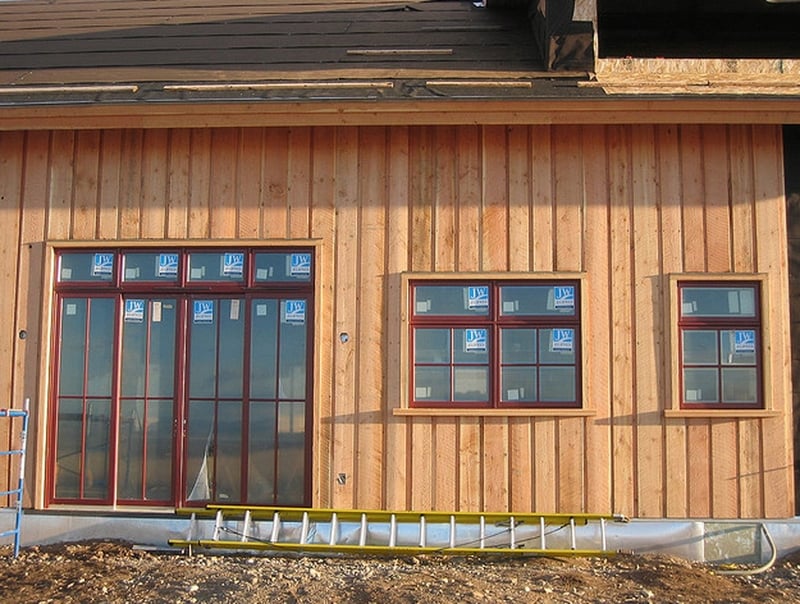
Installing it Vertically
You can choose to have shiplap or simply lap siding installed vertically, however it’s important to note that any vertical siding installation will generally be more difficult. You may be missing the supporting elements to otherwise attach the siding to.
Additionally, it doesn’t provide as good protection against water leaks either. The advantage of having siding installed horizontally is that it helps protect the home against water leaks. With horizontal installation, the water will just run off. While most of it will run off with vertical installation too, it’s still testing the seams where the different boards are connected.
While you may choose to go vertical instead for the visual appeal, it generally doesn’t make sense in terms of ease of installation or protection against the elements.
Other Siding Styles
There are also other siding styles that you could consider, and we do believe that it’s worth it to simply mention those, and you can then either choose to pursue further researching them, or you can stick with shiplap.
Wooden Shingles and Shakes
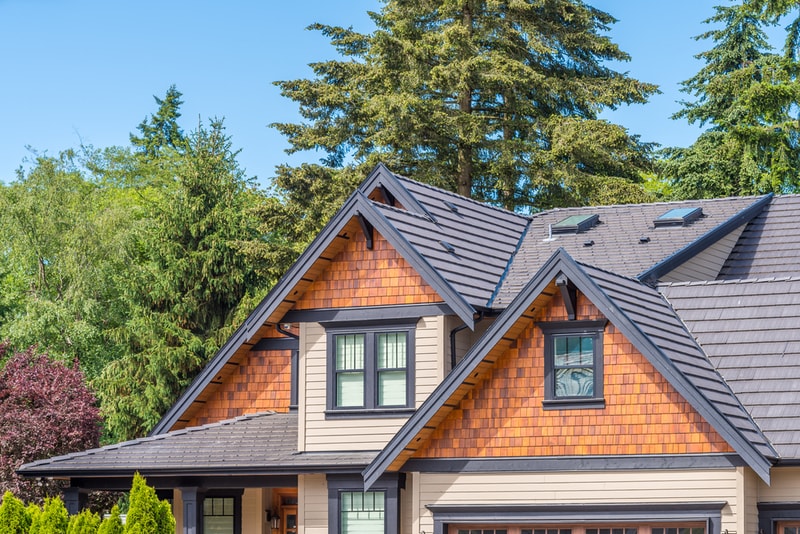
Shingles and shakes are traditionally made out of wood, although it is obviously no longer the only material that they come available in. The design options are only getting more and more advanced and vinyl and fiber cement are now also material options that you can look into.
They’re installed from bottom to top, the installation takes a significant amount of time, which makes it one of the more expensive siding styles to have installed too. It does provide better water-protection than vertical lap siding because there’s an overlap of materials that goes down towards the ground, making it easy for water to simply run off. In comparison to shiplap, shingle and shake siding is more difficult to repair too.
It does provide a higher end look but all the seams make it prone to insect damage such as from termites. Shiplap is easier to clean and paint/stain too.
Shingles come in different styles: Straight edge, perfection, staggered edge, octagons, half rounds, scallops and more. The choice of style all depends what kind of curb appeal you want.
Log Siding
Log siding is traditionally also made from wood but it has become more popular to start producing the logs from concrete instead. While they don’t require the same amount of maintenance because of the material, they are extremely heavy and additional support may be needed in order to handle the additional weight.
Wooden Materials Shiplap is Commonly Made From
There are a bunch of wooden materials that are often used for shiplap. Let us walk you through some of the different options so that you can get a good idea about whether it is the right material for you to choose or not.
Cedar
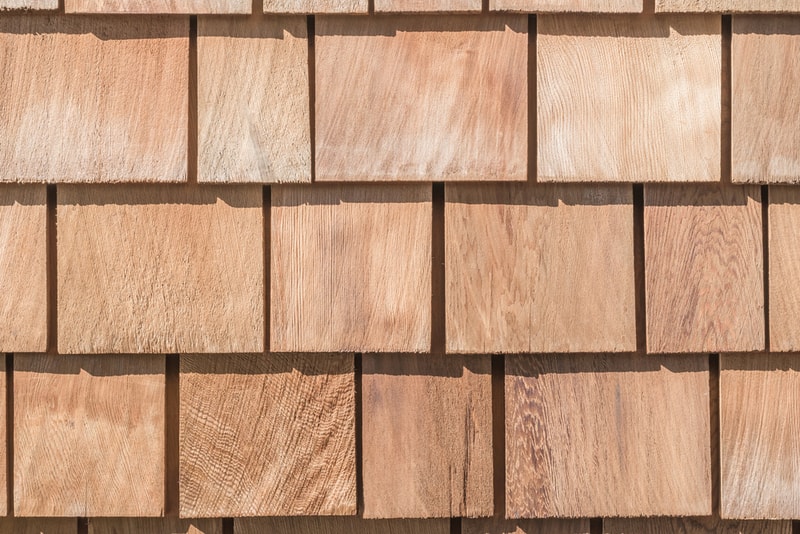
Cedar is a popular material to make shiplap with, and we have in fact created an article that is completely dedicated to cedar siding which we encourage you to read if you’re considering it. It includes a more thorough list of pros and cons as well as cost information and much more that you might be finding useful.
The more full explanations of all the sub-points you’ll also better be able to find in the article.
Pros of Cedar
- When compared to other types of wood siding, cedar is stronger and more durable.
- It’s a good way to go green that protects well against hail too.
- It looks beautiful, and much more beautiful than the materials made to imitate it (vinyl, fiber cement…).
- It accepts stain very well.
- It’s competitively priced if you’re looking at alternatives that would have the same benefits.
- It’s reclaimable.
- It provides great insulation.
- It provides greater protection against a lot of insects
Cons of Cedar
It has the same cons that different wooden materials do, meaning it needs maintenance and must be stained or painted.
If you like being visited by woodpeckers, it’s also a good material to go with, but chances are you find them a nuisance when they’re pecking away at your home, which is why we have put it in the section containing disadvantages.
Pine
Pine is a softwood which means there are certain things that naturally become the case because of it. We’ll quickly list the different advantages and disadvantages below so you can make up your own mind. You should also know that the yellow pine is stronger than the white pine.
Pros
- Softwood is cheaper than hardwood and that’s also the case with pine.
- It accepts stain and sealant very well too.
Cons
- Pine is more likely to have knots in it and that could become problematic.
- Fast-growth pine will have more problems than other types of wood.
- It is not as rot-resistant as other options which makes maintenance even more important.
Redwood
Shiplap siding can also be purchased using redwood and here are the most notable pros and cons using this material.
Pros
- Its red color can truly be beautiful if that’s the look that you want.
- There are many different grades to choose from and it could be your budget that ends up determining which choice to go with.
- You can get “clear” grades of redwood which means it’s clear of knots.
- It’s smoother than cedar.
- Redwood is arguably more sustainable than cedar since the manufacturers claim they grow more than is being harvested. Yay, go nature!
- Redwood is incredibly durable.
Cons
- It costs more than the comparable cedar.
- It doesn’t accept stain quite as well as cedar does. If you stain it, it’s easier getting the desired color with the more color-neutral cedar.
- Improperly maintained redwood will turn more gray over time.
Cedar and redwood are often compared to each other and your personal preference might be what ends up deciding between one option or another.
Ipe
Ipe can also be used for your shiplap siding projects. The material has the following pros and cons.
Pros
- It’s a very durable hardwood that resists insects very well.
- It’s supposedly stronger than cedar and redwood too.
- It’s VERY fire-resistant for a wood material.
- Mold and fungus is unlikely to be a big problem, especially when properly maintained.
- It’s very termite resistant too.
- It’s a stable type of wood that doesn’t warp a lot.
- The way it looks is obviously worth mentioning here.
Cons
- The wood is in fact so hard that it makes it harder to drill through, which makes the installation more difficult too.
- It’s definitely not a cheap option to go with.
- It could be harvested illegally. Look for an FSC certification to know that it wasn’t.
Cypress
Being a hardwood, using cypress for shiplap has a lot of the same pros as other hardwood.
Pros
- A lot of it comes from salvaged materials, meaning you’re helping by giving the material new life.
- It’s light compared to other materials while still being rot-resistant.
- It offers good protection against insects.
Cons
- It’s not cheap.
Vinyl

Vinyl isn’t the material that was originally used for shiplap siding, and it’s generally more available in other types of lap siding. Considering the use of vinyl has a lot of advantages in comparison to wooden products which is why people choose it. It won’t be the same, but the intention is for you to have as much information before deciding as possible. You can also read our article on vinyl siding.
Pros
- Vinyl can be made to look like wood, although it isn’t.
- The premium types of vinyl are durable and don’t require a lot of maintenance.
- It doesn’t rot or attract insects, which is very appealing to a lot of people.
Cons
- It doesn’t look as good as real wood does.
- If impacted, it can crack and won’t always be easy to swap out because of the way it’s installed.
- The standard vinyl only provides a very limited amount of insulation, although you can get premium versions that have additional insulation in them.
Fiber Cement
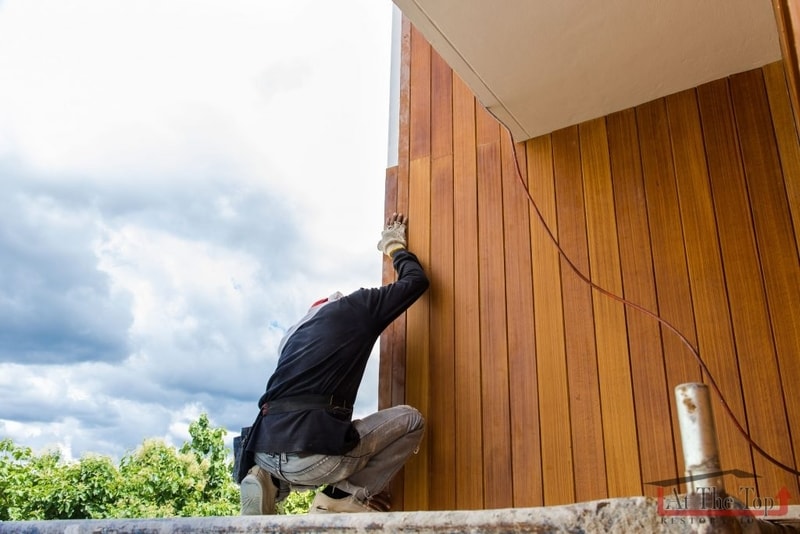
Fiber cement is also being used for lap siding and while it’s been around for a long time, it’s only been in later years that its popularity has started to rise. One of the main ingredients in fiber cement is Portland cement, which was also previously mixed in order to create asbestos siding. Fiber cement has come a long way since those days and now offer a variety of benefits as a material.
We also wrote a very extensive article on fiber cement.
Pros
- Fiber cement is probably the closest a material comes to looking like cedar without actually being it.
- It doesn’t have the same requirements for maintenance as wood.
- It’s incredibly durable.
- The fire-resistance makes it popular in very dry areas.
- It offers good value for money.
- The fact that it’s often made from recycled wood helps make it a green option.
- It expands and contracts less than other siding materials, especially when compared to wood.
Cons
- It’s imperative that it’s installed by fiber cement siding contractors to have it done correctly.
- The material can crack if it’s not handled properly and the initial installation cost may be a little bit higher than for other materials.
How Much Does Shiplap Cost Per Square Foot?
The cost of shiplap siding will very much depend on the type of material you choose to go with. When computing your cost, it’s important to calculate that there should be sufficient room in your budget to allow for the costs associated with maintenance of the product.
The most common cost of material ranges from $1-4 per square foot for shiplap siding. It ranges quite substantially since lower grades of wood are significantly cheaper than more expensive ones.
Nails for Shiplap Siding
For any type of siding, whether it’s shiplap or not, it’s best to use nails that are weather-resistant. What does that mean? It means that you can either go for stainless steel ones or ones that have been galvanized. The latter are a cheaper option for you to choose.
Does Wooden Shiplap Come Primed?
A lot of shiplap products come primed when you buy them if they’re meant to be painted. This is done to save the homeowner from the hassle of having to prime the material themselves and it therefore means that the material is ready to be either stained or painted in the colors and textures that you desire.
However, if you need material that isn’t primed, make sure to check it out before ordering a big delivery of it.
Installation Tips
If you’re considering doing the installation of shiplap siding yourself, an important tip is to keep in mind that wood will expand and contract slightly, and the boards shouldn’t be installed so tightly together that that becomes an issue.